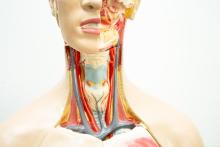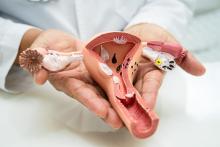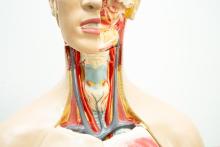חדשות המחקר

Raymond Farah, Rola Khamisy-Farah, George Arshed, Rashed Khatib, Salman Zarka: Role of Platelet-to-Lymphocyte Ratio and Other Markers in Predicting Severity and Prognosis in COVID-19 Patients (Isr Med Assoc J . )
Coronavirus disease 2019 (COVID-19) is a respiratory illness with broad spectrum of clinical manifestations ranging from asymptomatic cases to severe complications such as acute respiratory failure, multi-organ dysfunction, and death. Objectives: To evaluate the platelet-lymphocyte ratio (PLR) as a marker of disease severity and mortality in COVID-19 patients. To explore the relationship between PLR and other inflammatory indicators, specifically C-reactive protein (CRP) and neutrophil-lymphocyte ratio (NLR).

Karl Skorecki: APOL1 Dynamics in Diabetic Kidney Disease and Hypertension (Biomolecules .)
APOL1 Renal Risk Variants (APOL1RRVs, G1, and G2) are known to be toxic to glomerular podocytes and causally associated with an enhanced prevalence and progression of many different etiologies of chronic kidney disease (CKD), leading to the delineation of a new disease designation of APOL1-Mediated Kidney Disease (AMKD). Notably, APOL1RRVs have not consistently been shown to increase the prevalence or severity of diabetic kidney disease (DKD) progression, which is the most common cause of End-Stage Kidney Disease (ESKD). While this apparent discrepancy seems perplexing, its clarification should provide important mechanistic and therapeutic insights.

Sofia Soltsman: Pregnancy and Obesity – Prevention of Obesity in the Next Generation (Harefuah .)
Obesity is a feature affecting nearly all life aspects. As the burden of obesity is increasing steadily, it leads to the increasing prevalence of diabetes, and most other common non-communicable diseases. A comprehensive approach for the prevention of obesity appears to constitute the most effective intervention to reduce their prevalence worldwide. In this review, we highlight pregnancy as a key period in a woman's life, which can improve compliance with different types of diet, physical activity, and behavioural programs, affecting the next generation's health, and breaking the vicious cycle of family obesity.

Dor Ezon, Hagay Shwartz, Sagi Gleitman, Zeev Israeli, Edo Y Birati: Prognosis of Out-of-Hospital Cardiac Arrest in Underserved Rural Area (Clin Cardiol .)
Epidemiological data are lacking on patients in the rural areas who are being admitted after out-of-hospital cardiac arrest (OHCA). We report here the first descriptive analysis study of patients who were hospitalized and treated after OHCA at an academic medical center in the Lower Galilee which located in the north part of Israel.

Alaa Safia, Rabie Shehadeh, Adi Sharabi-Nov, Yaniv Avraham, Ohad Ronen, Shlomo Merchavy: Hypothyroidism After Hemithyroidectomy: A Retrospective Analysis of Temporal Trends and Key Risk Factors (J Clin Med . )
Post-hemithyroidectomy hypothyroidism is a recognized complication, though its incidence and risk factors remain variably reported. This study aimed to determine the incidence of hypothyroidism post-hemithyroidectomy, identify associated risk factors, and assess temporal changes in thyroid hormone levels.

Paul Kuodi: Prevalence and risk factors of under-five mortality due to severe acute malnutrition in Africa: a systematic review and meta-analysis (Syst Rev . )
Despite a global drop of under-five mortality by 59% between 1990 and 2019, it remains high in Low- and Middle- income Countries (LMICs)with a preponderance in Sub-Saharan Africa (SSA), Southern and Central Asia. Besides preterm and intrapartum complications, undernutrition contributes 45% of the deaths in these developing regions. In Africa, under-five mortality due to severe acute malnutrition (SAM) has stagnated at 10-40%, higher than WHO targets and the SDGs projections.

Zaina Adnan: Metastatic papillary thyroid carcinoma with internal jugular vein tumor thrombus - A case report and review of the literature (Front Endocrinol (Lausanne) . )
Papillary thyroid carcinoma (PTC) is the most common malignancy of the thyroid gland, typically associated with an indolent course and favourable prognosis. However, although rare, PTC can demonstrate aggressive behaviour, including vascular invasion with extension into major vessels. Intraluminal tumor thrombus involving the great veins, such as the internal jugular vein (IJV), is an uncommon but significant complication. We present the case of a 56-year-old male who was referred to our clinic for evaluation of a right-sided anterior neck mass.

Abeer Suleiman, Shlomo Battino, Olga Kuzmin, Enav Yefet: Oral Probiotics to Prevent Recurrent Vulvovaginal Infections During Pregnancy-Multicenter Double-Blind, Randomized, Placebo-Controlled Trial (Nutrients .)
During pregnancy, vulvovaginal infections (VVIs), including abnormal vaginal flora (AVF), bacterial vaginosis (BV), and vulvovaginal candidiasis (VVC), are associated with serious complications and discomfort. We aimed to elucidate the effectiveness of oral probiotics in secondary prevention of VVIs in pregnant women.

Yara Alkeesh, Inbar Ben-Shachar, Naama Marcus: Long-term Outcomes of Laparoscopic Sacrohysteropexy with SERATEX® SlimSling® Mesh: A Retrospective Case Series (Int Urogynecol J . )
Pelvic organ prolapse (POP) surgery has evolved toward minimally invasive techniques. Laparoscopic sacrohysteropexy (LSHP) is associated with reduced morbidity and lower mesh exposure risks. This study evaluates the long-term outcomes of LSHP using the SERATEX® SlimSling® mesh for isolated uterine prolapse.

Chava Kurtz, Sivan Spitzer: Patient Performance of Care Tasks During Acute Hospitalisation: A Scoping Review (J Clin Nurs . )
Patient self-care is established as improving outcomes, yet acute care in hospitals is provided such that patients tend to be passive recipients of care. Little is known about the extent and type of patient participation in treatment care tasks in acute hospital settings. Aims: To map and synthesise available literature on self-performance of care tasks in acute hospital settings.

Yarden Machlouf, Barak Levit, Alaa Awad, Adva Rom, Ory Wiesel: The differences in injury patterns and outcomes of thoracic trauma between rural and urban level two trauma centers in a single country (Eur J Trauma Emerg Surg .)
Equal level trauma centers in the same country might have significant differences regarding their demographics and types of trauma. Understanding geographic variations in injury patterns are essential for optimal care. Here we describe the differences in injury patterns and associated outcomes of thoracic trauma patients between rural and urban level-II trauma centers in a single country.


Jacob Bornstein: Immunogenicity of the 9-valent human papillomavirus vaccine: Post hoc analysis from five phase 3 studies (Hum Vaccin Immunother .)
Post hoc analyses of 9-valent human papillomavirus (9vHPV) vaccine immunogenicity were conducted in five Phase 3 studies that enrolled males.

Naim Shehadeh: Analysis and Visualization of Confounders and Treatment Pathways Leading to Amputation and Non-Amputation in Peripheral Artery Disease Patients Using Sankey Diagrams: Enhancing Explainability (Biomedicines . )
This study uses Sankey diagrams to analyze treatment pathways in patients with peripheral artery disease (PAD), which is a vascular condition characterized by atherosclerotic occlusion of the arteries, particularly in the lower limbs, affecting up to 14% of the general population. This study focuses on the treatment pathways that lead to amputation versus those that do not, utilizing the STARR dataset and the All of Us dataset.

Tarek Assaf, Wisam Abboud, Amir Mari: The Dynamic Evolution of Eosinophilic Esophagitis (Diagnostics (Basel) . )
Eosinophilic esophagitis (EoE) is a chronic, immune-mediated inflammatory condition of the esophagus characterized by eosinophilic infiltration, and hallmark symptoms of esophageal dysfunction such as dysphagia and food impaction. Over the past three decades, EoE has been recognized as a distinct clinical entity, distinguished from gastroesophageal reflux disease (GERD) through advancements in diagnostic techniques, particularly endoscopy with biopsy.



